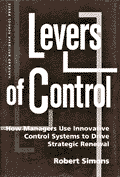"Levers of Control: How Managers Use Innovative Control Systems to Drive Strategic Renewal" by Robert Simons
Levers of Control: How Managers Use Innovative Control Systems to Drive Strategic Renewal by Robert Simons (217 pages, Harvard Business School Press, 1995)
(originally published by Booz & Company) One of our clients uses Robert Simons' Levers of Control as a kind of management bible. The C.E.O. gives the book to his immediate staff and direct reports and puts them through workshops conducted by Mr. Simons himself that focus on using the book's four major levers of analysis and control. The client's annual business planning process specifically asks managers how they intend to implement the management systems described in Mr. Simons' book. So the question to ask is this: is any book worth all this effort? The answer is yes—but with a caveat.
One of our clients uses Robert Simons' Levers of Control as a kind of management bible. The C.E.O. gives the book to his immediate staff and direct reports and puts them through workshops conducted by Mr. Simons himself that focus on using the book's four major levers of analysis and control. The client's annual business planning process specifically asks managers how they intend to implement the management systems described in Mr. Simons' book. So the question to ask is this: is any book worth all this effort? The answer is yes—but with a caveat.
Mr. Simons, a professor at the Harvard Business School, is onto something big and important. In the business environment of the 1990's, with its simultaneous demands for innovation and discipline, Mr. Simons, like many other management theorists and writers, asserts that traditional hierarchical command and control systems are obsolete. Traditional systems tie management's hands and deliver neither strategic responsiveness and adaptability nor the means to maximize the performance of a given strategy. Traditional systems have too little control over results, something many C.E.O.'s have learned firsthand.
With such a sharp framing of the problem, you would expect Mr. Simons to lay out a ringing manifesto for business leaders, à la Tom Peters: here is what needs to be done and here is how to change.
But that is not the path that Mr. Simons takes. Instead, he pursues a deeper and more thoughtful approach that is summed up in the book's subtitle: How Managers Use Innovative Control Systems to Drive Strategic Renewal. Mr. Simons defines those systems precisely. He writes that "management control systems are the formal, information-based routines and procedures managers use to maintain or alter patterns in organizational activities." Knowledge is power, especially when it is used to monitor and change behavior in an effort to bring about desired results.
Rather than provide easy answers about how to accomplish this, Mr. Simons instead gives the reader a new system of classification with which to work—a Dewey decimal system of management.
The system contains within it what Mr. Simons calls the "four levers of control." He postulates that in addition to diagnostic control systems (the first lever and his phrase for the traditional systems used to monitor and adjust operating performance—e.g., business plans, budgets, financial and cost-accounting systems), three systems or levers are required to control strategy and produce results. The additional levers or systems are as follows:
- Belief systems that communicate core values such as mission statements, credos and vision statements.
- Boundary systems that define the limits of freedom, such as codes of conduct and ethics statements.
- Interactive control systems that provide strategic feedback and vehicles to update and redirect strategy such as competitive analysis and market feedback reports.
Few C.E.O.'s would disagree that these levers are important to running a business. They will always be important. But what Mr. Simons offers is a new set of terms for defining and classifying the whole array of familiar management tools from the perspective of the lever/management system concept. This simple act of classification presents the reader with a deeper understanding of how to use, organize and structure the management mechanisms already on hand. Such a redefinition of terms extends a manager's control over results and broadens the notion of what is possible.
In Mr. Simons' new terminology, M.I.S. is not just M.I.S. anymore; it's a diagnostic control system. Market share analysis is now an interactive control system. As Mr. Simons himself says, "Strategic control is not achieved through new and unique systems, but through belief systems, boundary systems, diagnostic control systems and interactive control systems working in concert to control both the implementation of intended strategies and the formulation of emergent strategies."
What is striking about the case examples Mr. Simons cites is not that the senior executives use all of these systems in various combinations and levels. Rather, it is how hard they work to define their business strategy and personally intervene to make certain that everything the organization does is consistent with that strategy. Sure, they use every one of Mr. Simons' four levers, but so do most companies. Yet the successful ones are different because top management has consciously and deliberately embedded business strategy into every management system, lever and process. That goes a long way toward aligning the entire company around its real aims.
There is one caveat, however, that must be considered when using this valuable book. It is that managers will be tempted to employ it as a checklist and rush off to build all the levers before they have a tightly defined set of strategic priorities.
Equipping management systems to control strategy is hard work, as Mr. Simons says. Managers have to understand their strategies incredibly well. They have to stick to them. They have to understand the true causal relationships between strategic and operating decisions and how they are linked to financial performance. As a result, Levers of Control will most likely prove to be far more valuable to an organization that has already been through a strategic renewal process and is seeking a rich array of reinforcement mechanisms, than to a company just starting down the path.
This is a good book; it is just not for beginners. ![]()



